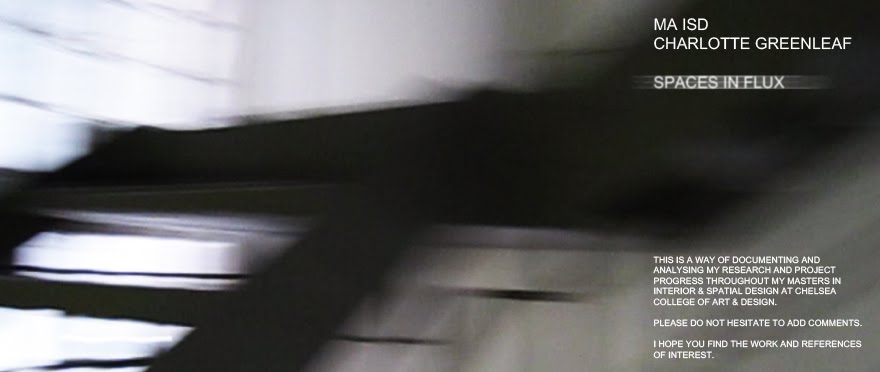Concerns
- Transience in today’s culture - Every day, the average human fluxes through a series of juxtaposing internal and external spaces which reveal and obscure themselves to us as we journey from one destination to another. In viewing spaces in a state of motion, we immerse ourselves in a continuous movement of shifting orientations and crossed viewpoints, where our perceptions of space change as we progress.
- Travel – gradual transition from one environment to another
- I am concerned with the participation of the viewer within spaces, whereby through experiencing spaces in a state of flux, the juxtaposition of movement and stillness results in activating and revealing the space.
- I am concerned with a visual interplay with the way we see space so that the viewer’s positioning has a direct effect on how space is seen. This relates to an interest in the ability to change and obscure a space’s visual identity and transform our attention to surrounding environments. Environments which appear to be moving, but in reality are not - Creating a visually dynamic environment.
- Physically kinesthetic form of design and modelling of space
- Architectural journey – Spatial interactive experience between body and space
- Trajectories – path of a moving object through space
- Architecture that involves an unfolding experience as the viewer moves through it – sequential experience - associated with the cinematic concept of architectural montage, artificially created continuous spaces.
- The virtual transient exploration and manipulation of space in cinema, in relation to the visual experiential sequencing of space in architecture and installation art.
- My inquiry concerns movement and its relation to spatial manipulation.
- How we visually comprehend space through movement and how we can design to enhance the average experience of moving through a space.
Discussion
This discussion was focussed around how to subsequently progress from the 'Movement Films'. Each of the films were filmed in a fairly unplanned and impulsive manner, subsequently they have many similarities and differences. It therefore seems logical to derive a way to conclude the films as a whole, in a planned sequence film. A film which (like all cinema) has the ability to deliberately move the viewer through a space in a particular way.
This could be done through designing a mechanical device that holds a camera and which allows me to film in a particular way:
(It therefore seems sensible to initially analyse the current films in depth in order to devise the device)
- As a means of controlling the camera movement (dollies)
- Moving in two directions, roller coaster mechanism
- Maybe the camera records the mechanism
- Where is the spatial manipulation done? Unedited film - could enable me to avoid editing by computer software
- Complex mechanisms
- Using the twist / spiral - which has been concurrent through a lot of my work - compound movements - more than in one direction
- The device as a process to the next step
- Looking for buildings which have twisting movement qualities - but also devise a mechanism which allows me to film other spaces
- How the movement might really start to engage the space
- What it reveals when it twists
- Film the device - relationship between the device and the image
- How I show the films - a mechanism/monitor that moves
The films may then generate a particular play of geometry which i develop in a sculptural / architectural way - draw films - translate that back. Draw mechanisms.


No comments:
Post a Comment